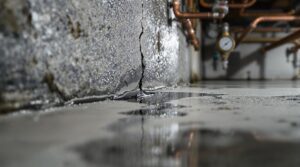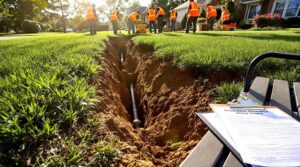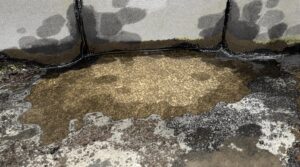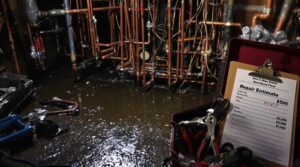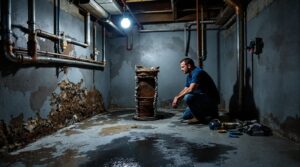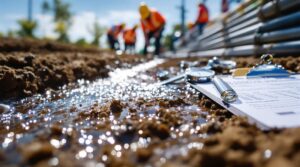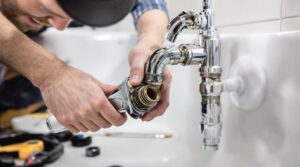Water line replacement costs average $3,500 nationwide, ranging from $620 to $12,500. The total expense depends on installation method, pipe material selection, and site-specific conditions. Trenchless methods cost $70-$250 per linear foot, while trenched installations range from $50-$200 per linear foot. Labor typically comprises 35-60% of total costs. Material options include PVC ($0.50-$5/ft), PEX ($0.40-$2/ft), and copper ($2-$10/ft). Understanding additional cost factors can lead to significant project savings.
Key Takeaways
- Water line replacement averages $3,500, with costs typically ranging from $620 to $12,500 depending on installation method and location.
- Trenchless replacement costs $70-250 per linear foot, while traditional trenched methods cost $50-200 per linear foot.
- Material costs vary significantly: PVC ($0.50-5/ft), PEX ($0.40-2/ft), copper ($2-10/ft), and cast iron ($2-10/ft).
- Labor typically represents 35-60% of total project costs, with additional inspection fees ranging from $100 to $500.
- Key cost factors include pipe length, depth, site accessibility, material choice, and local building requirements.
Average Water Line Replacement Costs by Method
When evaluating water line replacement options, homeowners face two primary methods with distinct cost implications.
Trenchless water line replacement typically ranges from $70 to $250 per linear foot, while trenched water line replacement costs between $50 and $200 per linear foot, making it generally more economical.
The average cost for a complete water line replacement project falls around $3,500, though total project costs can vary considerably from $620 to $12,500. Factors affecting these costs include pipe materials, accessibility, and location.
In high cost-of-living areas, trenchless installations can reach the upper range of $250 per linear foot. While trenched methods offer initial savings in plumbing service costs, they often require additional landscaping restoration expenses, which can add $3,500 or more to the final bill.
Homeowners must carefully weigh these factors, considering both immediate installation costs and potential restoration expenses when selecting their preferred replacement method.
Pipe Material Options and Price Comparison
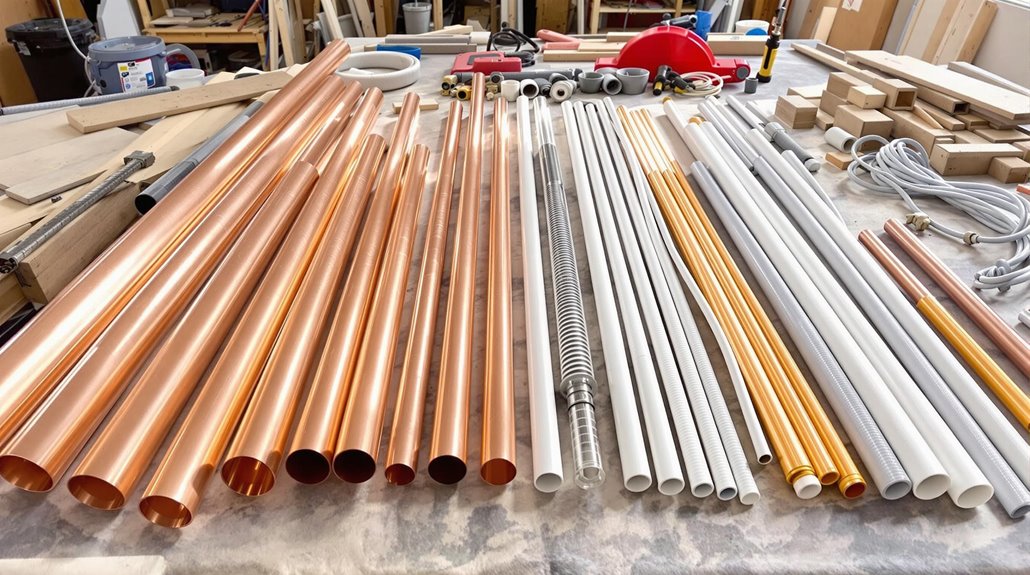
A diverse range of pipe materials provides homeowners with varying cost-benefit options for water line replacement projects.
PVC pipes remain the most economical choice at $0.50-$5 per linear foot, making them prevalent in new construction plumbing systems.
PEX pipes offer flexibility and freeze resistance at $0.40-$2 per linear foot, while cast iron pipes provide durability at $2-$10 per linear foot despite potential corrosion concerns.
- Copper pipes ($2-$10 per linear foot) deliver exceptional durability but may require additional maintenance due to corrosion susceptibility.
- Fiberglass-reinforced plastic pipes ($5-$10 per linear foot) offer superior corrosion resistance but can be affected by temperature changes.
- PVC pipes present the best value for standard residential applications, balancing cost and performance.
- PEX pipes emerge as a prime choice for regions experiencing extreme temperature variations.
When conducting a price comparison, homeowners must consider not only initial material costs but also long-term maintenance requirements and environmental factors affecting each pipe material's performance.
Labor and Installation Expenses Breakdown
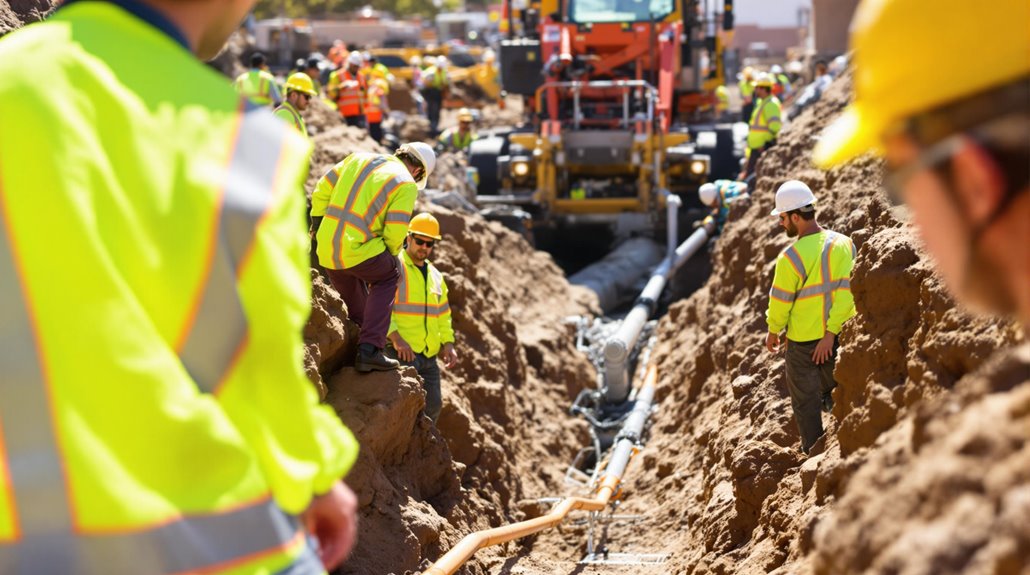
Beyond material costs, labor and installation represent the most substantial portion of water line replacement expenses. Labor costs typically constitute 35% to 60% of overall expenses, with variations depending on the chosen installation method.
The trenchless method ranges from $75 to $150 per linear foot, while traditional trenched methods cost between $50 and $250 per linear foot.
Project complexity greatly influences labor requirements and associated costs. Factors such as underground obstructions, accessibility challenges, and depth requirements can necessitate additional contractors and extend work duration.
The trenchless method, while often more efficient, demands specialized skills and equipment, leading to higher labor expenses. Experienced contractors are essential for successful implementation.
Inspection costs, ranging from $100 to $500, add to the total project expenses. These assessments are vital for ensuring proper installation and system functionality, regardless of whether traditional trenched or trenchless methods are employed.
Key Cost Factors for Main Line Projects
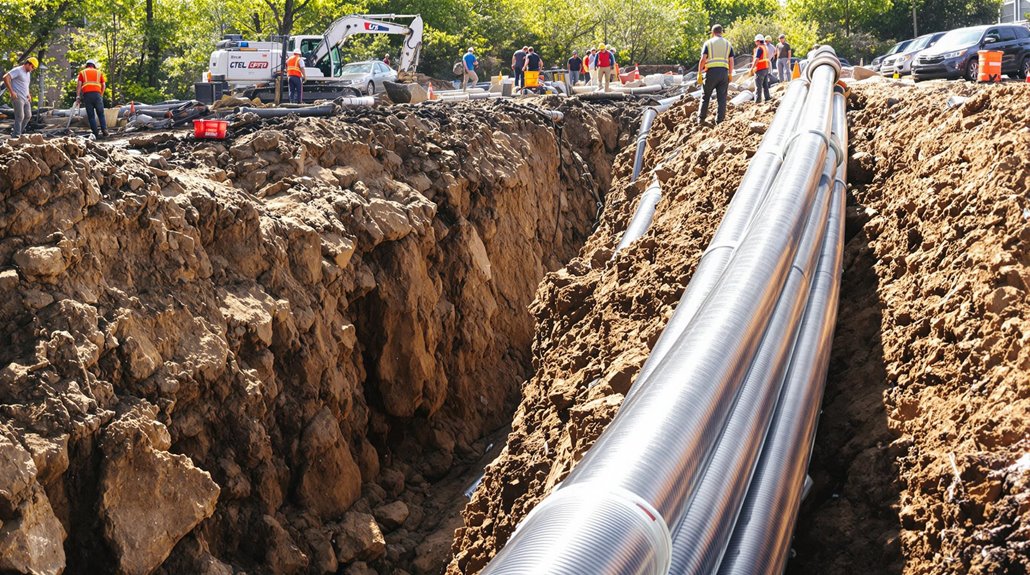
The total cost of water line replacement projects varies greatly based on several critical factors, with the national average ranging from $1,500 to over $10,000. Understanding these key factors helps homeowners prepare for main water line installation expenses and make informed decisions about their replacement projects.
- Length and depth of the main water line greatly impact labor costs, as longer and deeper installations require additional time and resources.
- Site accessibility affects equipment requirements and labor intensity, potentially increasing project costs in challenging locations.
- Pipe material and diameter choices influence both material costs and installation complexity.
- Additional expenses may arise from addressing site-specific obstacles, such as tree root removal or rock excavation.
These cost factors combine to determine the final project expense, which averages approximately $3,800 nationwide.
Professional contractors assess these elements during initial site evaluations to provide accurate cost estimates for water line replacement work.
Tips for Reducing Water Line Replacement Expenses
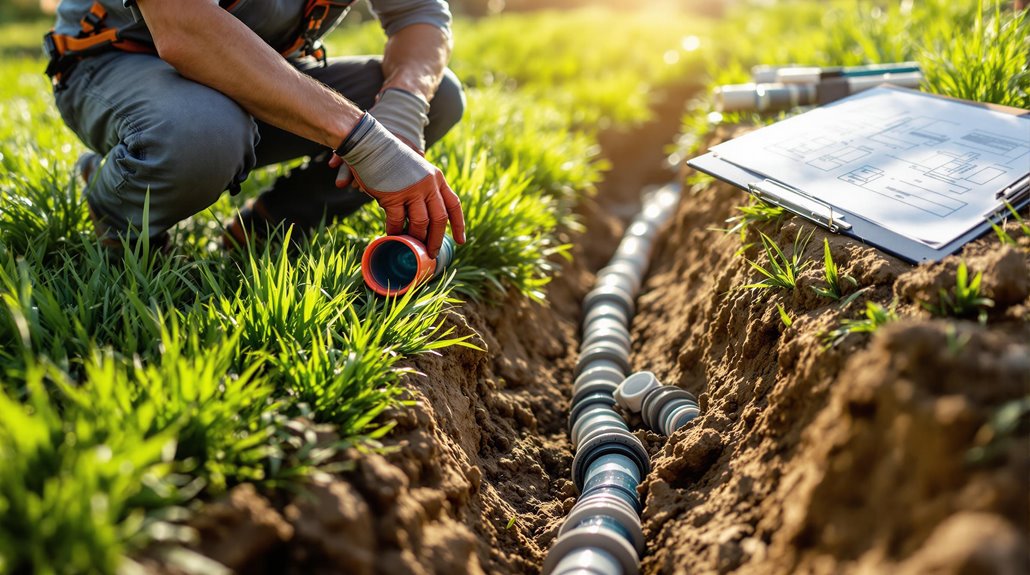
While water line replacement represents a considerable investment, homeowners can implement several strategic approaches to minimize overall project costs. Selecting trenchless water main replacement methods can save considerably on landscaping restoration, with costs ranging from $75-$250 per linear foot. Choosing cost-effective materials like PVC or polyethylene pipes instead of copper can greatly reduce material costs while maintaining quality standards.
| Cost Factor | Potential Savings |
|---|---|
| Material Selection | $19.50-$25 per foot |
| Installation Method | Up to $8,000 total |
| Timing of Service | 15-30% on labor |
| Early Detection | Up to $12,200 total |
Professional plumbers should be engaged during off-peak seasons when labor rates are more competitive. Regular inspections and prompt water line repair can prevent extensive damage and higher replacement costs. Understanding local building codes and maintaining proper documentation helps avoid costly corrections. Additionally, monitoring low water pressure and addressing minor issues promptly can prevent the need to replace the main water line entirely.
The Benefits Of Consulting A Public Adjuster

Public adjusters offer professional expertise in maneuvering complex water line replacement insurance claims, providing objective damage assessments that insurance companies are more likely to accept.
Their involvement typically results in considerably higher claim settlements, with studies showing increases of up to 800% compared to claims filed without professional assistance.
These licensed professionals streamline the claims process by managing documentation, negotiations, and settlement discussions, allowing property owners to focus on addressing immediate water line concerns.
Expertise In Insurance Claims
Steering insurance claims for water line replacement can be considerably more successful with professional assistance from a licensed public adjuster. These experts specialize in managing complex homeowners insurance policies and maximizing claim payouts for property damage.
Statistical evidence indicates that settlements handled by public adjusters average 40% higher than those dealt with independently, justifying their typical 5-15% service fee.
- Extensive evaluation of water line replacement costs and associated damages
- In-depth analysis of policy coverage and applicable claim components
- Professional documentation and substantiation of property damage claims
- Strategic negotiation with insurance carriers to optimize settlement amounts
Public adjusters' expertise in the claims process guarantees thorough assessment and fair compensation, particularly valuable when dealing with complex water line replacement scenarios that require a detailed understanding of insurance policy provisions.
Objective Damage Assessment
Obtaining an objective damage assessment from a public adjuster represents a significant advantage when addressing water line replacement costs.
These professionals provide an unbiased professional assessment that differentiates between necessary repair and replacement requirements, ensuring accurate cost evaluations.
Public adjusters conduct thorough evaluations of water line damage, documenting all affected areas with precision.
While their services typically cost 10-20% of the insurance settlement, their objective evaluation often leads to higher reimbursement amounts that justify the expense.
Their expertise in the claims process helps homeowners secure extensive coverage for the cost to replace damaged components.
Through detailed documentation and effective communication with insurance providers, public adjusters expedite the claims process while ensuring homeowners receive fair compensation for all documented damages.
This systematic approach helps validate the full scope of necessary repairs.
Streamlined Claim Process
When maneuvering the complex process of water line replacement claims, engaging a public adjuster markedly streamlines the insurance settlement procedure. These professionals facilitate negotiations between homeowners and insurance companies, ensuring extensive documentation of damages and costs.
Public adjusters possess expertise in determining whether insurance cover extends to specific water line replacement scenarios, often securing higher settlement amounts that accurately reflect true replacement costs.
- Thorough documentation and evidence collection for claims process optimization
- Expert assessment of water line replacement costs, ranging from $1,500 to $12,000
- Professional negotiation of settlements based on accurate damage evaluation
- Direct liaison with insurance companies to expedite homeowner's policy claims
Their specialized knowledge helps homeowners navigate policy complexities while ensuring costs do not include unnecessary expenses, ultimately maximizing the potential for fair compensation.
Higher Claim Payouts & Settlements
Public adjusters consistently demonstrate their value through considerably increased claim settlements for water line replacement projects. Statistical data shows that engaging a public adjuster can enhance insurance claim payouts by 30-70% compared to self-managed claims. Their expertise in policy interpretation and claims process management enables homeowners to maximize their settlement potential while minimizing personal stress.
| Aspect | Without Public Adjuster | With Public Adjuster |
|---|---|---|
| Claim Assessment | Basic evaluation | Thorough analysis |
| Documentation | Homeowner managed | Professional documentation |
| Plumber Coordination | Limited oversight | Expert coordination |
| Negotiation Power | Individual effort | Professional leverage |
| Settlement Amount | Standard payout | 30-70% higher payout |
While public adjusters charge 5-15% of the settlement, their specialized knowledge in property damage assessment and negotiations with insurance companies typically results in much higher compensation that offsets their costs.
About The Public Claims Adjusters Network (PCAN)
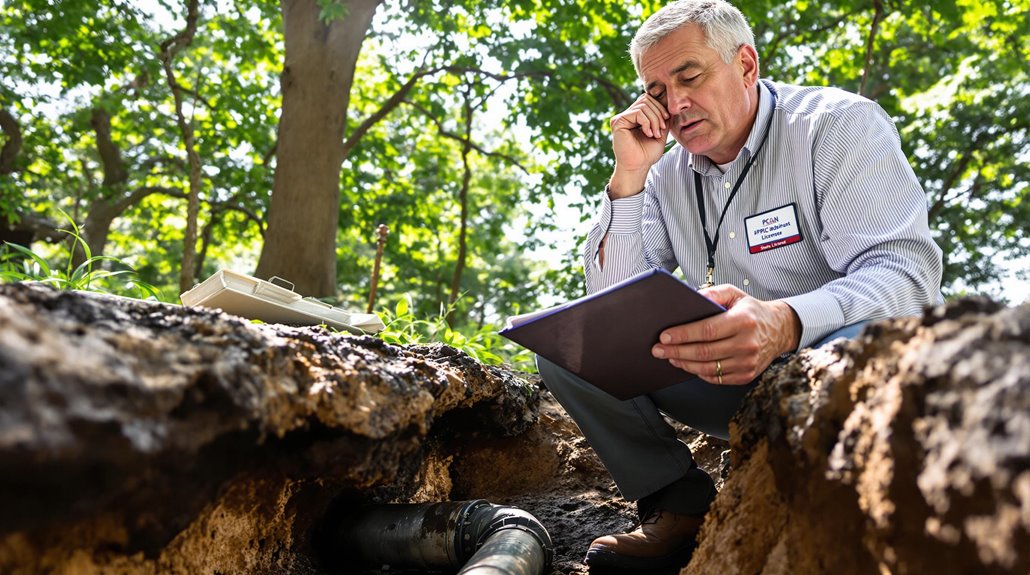
The Public Claims Adjusters Network (PCAN) operates as a nationwide organization of vetted, state-licensed professionals who specialize in handling residential and commercial property damage insurance claims.
This elite network maintains strict standards for membership, requiring adjusters to complete a rigorous application and interview process before admission. PCAN serves as an essential resource connecting homeowners with qualified public adjusters across 40+ states.
- Members must maintain active state licenses and undergo annual audits to verify compliance
- Network adjusters handle over 30 different types of property damage insurance claims
- All members adhere to strict professional ethics and moral standards
- Continuous monitoring guarantees maintenance of high-quality service delivery
PCAN's thorough vetting process and ongoing oversight guarantee that member adjusters maintain the highest levels of professional conduct and expertise.
This systematic approach helps establish trust between licensed adjusters and policyholders seeking assistance with their insurance claims, while maintaining the network's reputation for excellence in claims adjustment services.
Frequently Asked Questions
How Much Does It Cost to Replace a Water Line?
Water line replacement costs typically range from $3,500 to $5,000, varying by replacement methods, material choices, and local regulations. Factors affecting price include contractor fees, property conditions, and installation complexity. Additionally, homeowners should consider potential unforeseen expenses that may arise during the project, such as the need for excavation or additional permits. Accurate estimates can sometimes be misleading due to hidden issues with the existing infrastructure. Ultimately, understanding the main water line repair costs can help homeowners budget more effectively and choose the right contractor for the job.
Is the Main Water Line Covered by Insurance?
Standard homeowner insurance policies typically exclude main water line coverage unless specifically added. Coverage options vary by insurer, with separate riders or service plans available for plumbing issues and emergency repairs.
Who Is Responsible for the Water Line From Street to House?
From the street's underground network to the property line, municipalities maintain the main water line, while homeowners bear responsibility for the segment extending from the property boundary to their residence.
How Often Should Water Lines Be Replaced?
Water lines typically require replacement every 50-70 years, depending on pipe materials, environmental conditions, and maintenance history. Regular inspections can identify early signs of failure, helping homeowners plan proactive replacements.
